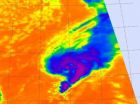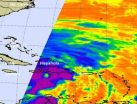(Press-News.org) When the era of regenerative medicine dawned more than three decades ago, the potential to replenish populations of cells destroyed by disease was seen by many as the next medical revolution. However, what followed turned out not to be a sprint to the clinic, but rather a long tedious slog carried out in labs across the globe required to master the complexity of stem cells and then pair their capabilities and attributes with specific diseases.
In a review article appearing today in the journal Science, University of Rochester Medical Center scientists Steve Goldman, M.D., Ph.D., Maiken Nedergaard, Ph.D., and Martha Windrem, Ph.D., contend that researchers are now on the threshold of human application of stem cell therapies for a class of neurological diseases known as myelin disorders – a long list of diseases that include conditions such as multiple sclerosis, white matter stroke, cerebral palsy, certain dementias, and rare but fatal childhood disorders called pediatric leukodystrophies.
"Stem cell biology has progressed in many ways over the last decade, and many potential opportunities for clinical translation have arisen," said Goldman. "In particular, for diseases of the central nervous system, which have proven difficult to treat because of the brain's great cellular complexity, we postulated that the simplest cell types might provide us the best opportunities for cell therapy."
The common factor in myelin disorders is a cell called the oligodendrocyte. These cells arise, or are created, by another cell found in the central nervous system called the glial progenitor cell. Both oligodendrocytes and their "sister cells" – called astrocytes – share this same parent and serve critical support functions in the central nervous systems.
Oligodendrocytes produce myelin, a fatty substance that insulates the fibrous connections between nerve cells that are responsible for transmitting signals throughout the body. When myelin-producing cells are lost or damaged in conditions such as multiple sclerosis and spinal cord injury, signals traveling between nerves are weakened or even lost. Astrocytes also play an essential role in the brain. Long overlooked and underappreciated, it is now understood that astrocytes are critical to the health and signaling function of oligodendrocytes as well as neurons.
Glial progenitor cells and their offspring represent a promising target for stem cell therapies, because – unlike other cells in the central nervous system – they are relatively homogeneous and more readily manipulated and transplanted. In the case of oligodendrocytes, multiple animal studies have shown that, once transplanted, these cells will disperse and begin to repair or "remyelinate" damaged areas.
"Glial cell dysfunction accounts for a broad spectrum of diseases, some of which – like the white matter degeneration of aging – are far more prevalent than we previously realized," said Goldman. "Yet glial progenitor cells are relatively easy to work with, especially since we don't have to worry about re-establishing precise point to point connections as we must with neurons. This gives us hope that we may begin to treat diseases of glia by direct transplantation of competent progenitor cells."
Scientists have reached this point, according to the authors, because of a number of key advances. Better imaging technologies – namely advanced MRI scanners – now provide greater insight and clarity into the specific damage caused in the central nervous system by myelin disorders. These technologies also enable scientists to precisely follow the results of their work.
Even more importantly, researchers have overcome numerous obstacles and made significant strides in their ability to manipulate and handle these cells. Goldman's lab in particular has been a pioneer in understanding the precise chemical signals necessary to coax stem cells into making glial progenitor cells, as well as those needed to "instruct" these cells to make oligodendrocytes or astrocytes. His lab has been able to produce these cells from a number of different sources – including "reprogramming" skin cells, a technology that has the advantage of genetically matching transplanted cells to the donor. They have also developed techniques to sort these cells based on unique identifying markers, a critical step that ensures the purity of the cells used in transplantation, lowering the risk for tumor formation.
Nedergaard's lab has studied the integration of these cells into existing neural networks, and well as in imaging their structure and function in the adult nervous system. Together, the two labs have developed models of both human neural activity and disease based on animals transplanted with glial progenitor cells, which will enable human neural cells to be evaluated in the context of the live adult brain – as opposed to a test tube. This work has already opened new avenues in both modeling and potentially treating human glial disease.
All of these advances, contend the authors, have accelerated research to the point where human studies for myelin disorders are close at hand. For instance, diseases such as multiple sclerosis, which benefit from a new generation of stabilizing anti-inflammatory drugs, may be an especially appealing target for progenitor-based cell therapies which could repair the now permanent and untreatable damage to the central nervous system that occurs in the disease. Similarly, the authors point to a number of the childhood diseases of white matter that now appear ripe for cell-based treatment.
"We have developed a tremendous amount of information about these cells and how to produce them," said Goldman. "We understand the different cell populations, their genetic profiles, and how they behave in culture and in a variety of animal models. We also have better understanding of the disease target environments than ever before, and have the radiographic technologies to follow how patients do after transplantation. Moving into clinical trials for myelin disorders is really just a question of resources at this point."
### END
Researchers at the doorstep of stem cell therapies for MS, other myelin disorders
2012-10-26
ELSE PRESS RELEASES FROM THIS DATE:
Traditional fisheries management approach jeopardizes marine ecosystems worldwide
2012-10-26
STONY BROOK, NY– In a Perspectives article, "The Risks of Overfishing," published today in the journal Science, Dr. Ellen K. Pikitch, executive director of the Institute for Ocean Conservation Science and professor at Stony Brook University, cautions against continuing traditional fisheries management. According to Dr. Pikitch, current and recent studies demonstrate the need for "a more precautionary approach to fisheries management, in which fishing is restricted to those places and amounts where it can be conducted safely and with minimal risk of jeopardizing the integrity ...
'Adoption activity days' can help children find new families
2012-10-26
Children's parties or activity days, where prospective adopters meet children awaiting adoption, could be part of the solution to the current adoption crisis, according to research that will be showcased during the Economic and Social Research Council (ESRC) Festival of Social Science.
"Such parties or activity days went out of fashion in the 1980s but no one is sure why," says Katherine Runswick-Cole of Manchester Metropolitan University who led the research. "However, our pilot study has shown an overwhelmingly positive response from practitioners, adopters and the ...
A black widow's Tango Mortale in gamma-ray light
2012-10-26
This press release is available in German.
Pulsars are the compact remnants from explosions of massive stars. Some of them spin around their own axis hundreds of times per second, emitting beams of radiation into space. Until now, they could only be found through their pulsed radio emissions. Now, scientists at the Max Planck Institute for Gravitational Physics (Albert Einstein Institute/AEI) in Hanover assisted by the Max Planck Institute for Radio Astronomy have discovered a millisecond pulsar solely via its pulsed gamma radiation. A new data analysis method developed ...
Smoking takes 10 years off life expectancy in Japan, not 4 as previously thought, experts warn
2012-10-26
Smoking reduces life expectancy by ten years in Japan, but much of the risk can be avoided by giving up smoking, a paper published on bmj.com today shows.
Previous studies in Japan suggested smoking reduced life expectancy by only a few years compared with about ten years in Britain and the USA. This new report, from researchers in Oxford and Japan, investigates the impact of smoking on mortality in a large group of Japanese people who were living in Hiroshima or Nagasaki in 1950. The findings are, however, nothing to do with radiation exposure from the bombs.
The ...
US investment in biomedical and health research on downward trend
2012-10-26
WASHINGTON, DC—October 25, 2012—Biomedical and health research and development (R&D) spending from all sources declined by more than $4 billion or 3% between FY10 and FY11 according to Research!America's 2011 U.S. Investment in Health Research report. This represents the first drop in overall spending since Research!America began compiling the data in 2002.
The decline follows an uptick in research funding attributed to the American Recovery and Reinvestment Act (ARRA), which allocated $10.4 billion to the National Institutes of Health (NIH) over two fiscal years (2009-2010). ...
NASA sees warming cloud tops indicating Tropical Storm Tony weakening
2012-10-26
In a tropical cyclone, strong uplift of air pushes the tops of thunderstorms high into the troposphere. When that strength wanes, the cloud tops drop and become less cold. That's because the higher you go in the troposphere, the colder it gets. NASA satellite infrared data has revealed that Tropical Storm Tony's cloud top temperatures are warming and the storm is weakening.
The Atmospheric Infrared Sounder (AIRS) instrument aboard NASA's Aqua satellite captured infrared imagery of Tropical Storm Tony on Oct. 24 at 12:17 p.m. EDT that showed the strongest thunderstorms ...
NASA sees power in Hurricane Sandy moving toward Bahamas
2012-10-26
NASA's Aqua satellite passed over Hurricane Sandy as it was moving over eastern Cuba early on Oct. 25. The AIRS instrument captured an infrared image of Sandy that showed a large area of very high, cold cloud tops indicating the power within the storm. Sandy is now headed toward the Bahamas and warnings and watches have already been posted for the mainland U.S.
The Atmospheric Infrared Sounder (AIRS) instrument aboard NASA's Aqua satellite captured infrared imagery of Hurricane Sandy's eastern half on Oct. 25 at 0559 UTC (1:59 a.m. EDT) that showed some strong thunderstorms ...
NASA saw Tropical Storm Murjan making landfall on the Horn of Africa
2012-10-26
NASA's Aqua satellite watched from space as Somalia in the Horn of Africa experienced a landfalling tropical cyclone on Oct. 25.
On Oct. 25, NASA's Aqua satellite saw Tropical Storm Murjan begin to make landfall in eastern Somalia, just south of Cape Guardafui. Cape Guardafui is located in the northeastern Bari province and forms the geographical point of the Horn of Africa.
On Oct. 25, 2012 at 0720 UTC (3:20 a.m. EDT) the Moderate Resolution Imaging Spectroradiometer (MODIS) instrument that flies aboard NASA's Aqua satellite captured a visible image of Tropical Storm ...
USF researchers identify gene mutation linked to old age hearing loss
2012-10-26
TAMPA, Fla. (Oct. 25, 2012) - University of South Florida researchers have identified a genetic biomarker for age-related hearing loss, a major breakthrough in understanding and preventing a condition of aging that affects 30 million Americans and greatly diminishes their quality of life.
In a nine-year study that was a collaboration between USF's Global Center for Hearing & Speech Research and the National Technical Institute for the Deaf at the Rochester Institute of Technology, researchers were able to identify the first genetic biomarker for presbycusis. The genetic ...
NASA sees Tropical Storm Son-tinh moving into South China Sea
2012-10-26
Tropical Storm Son-tinh soaked the Philippines and is now moving into the South China Sea. NASA's Aqua satellite captured a visible image of the storm as the bulk western half of the storm had already moved over water.
On Oct. 25, 2012 at 0525 UTC (1:25 a.m. EDT) the Moderate Resolution Imaging Spectroradiometer (MODIS) instrument that flies aboard NASA's Aqua satellite captured a visible image of Tropical Storm Sin-Tingh. The image showed that the western half of the storm had already moved into the South China Sea, while powerful thunderstorms in the eastern half were ...





